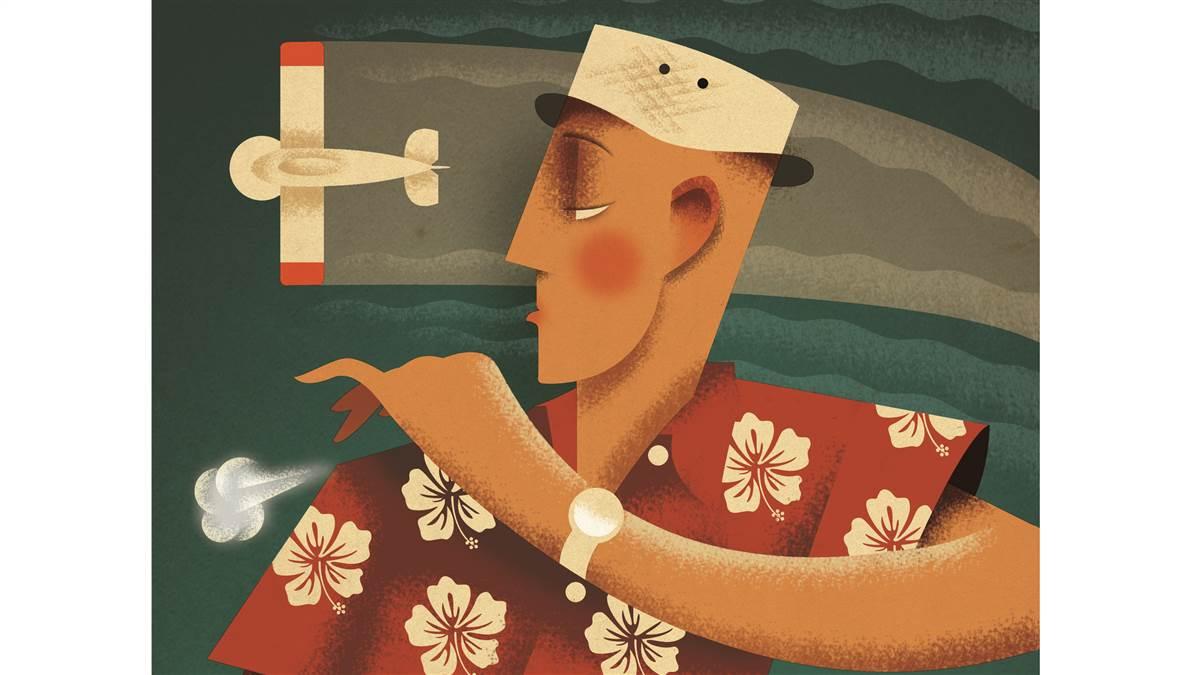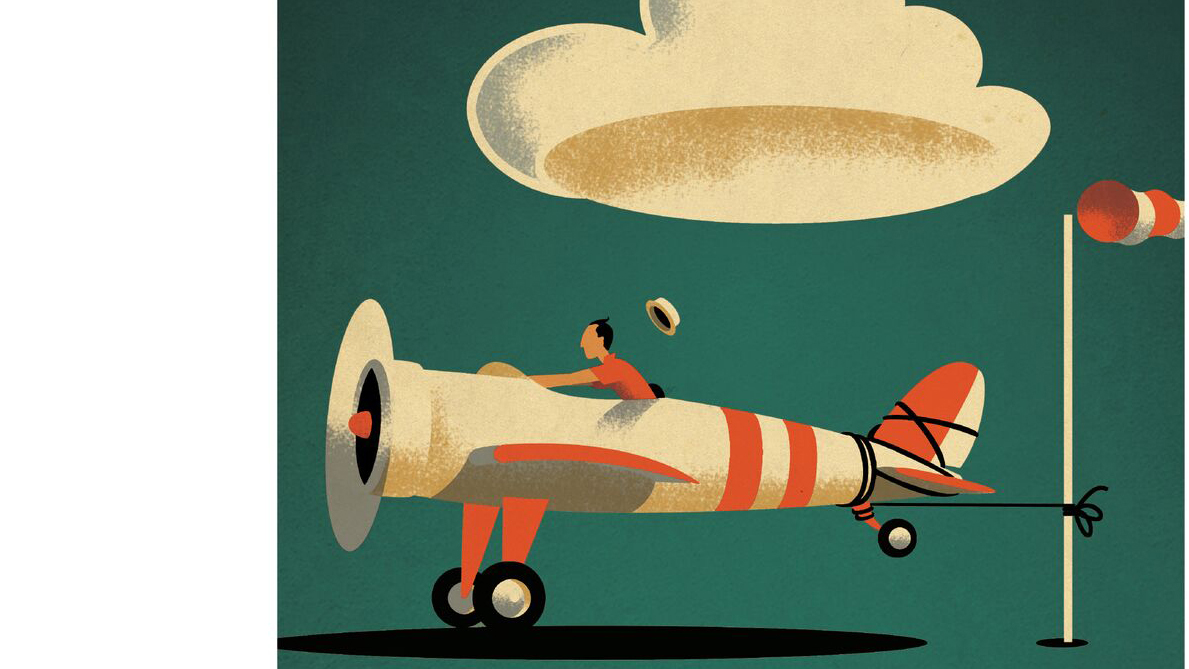Brush it Off
Don’t let mistakes slow you down

Edison is considered one of America’s most prolific inventors. He holds more than 1,000 patents, and many of his inventions were so revolutionary that they sparked entire industries. It’s easy to pass someone like Edison off as a genius for whom things came naturally, but for every idea that worked, he had 10 that didn’t. “I have not failed 10,000 times,” he said. “I’ve successfully found 10,000 ways that will not work.”
Learning to fly is not as difficult as inventing the light bulb, but the process of making mistakes and persevering through those mistakes applies to every learning process. The potential to succeed as a student pilot depends not on your natural ability, but in how you approach the learning process—and, perhaps most important, how you overcome the inevitable mistakes you’ll make along the way.
Objective achievement traditionally has been the most valued goal of education: As long as a student got a good grade (or in the case of pilot training, passed the knowledge test and practical test), nothing else really mattered. But researchers are starting to understand the importance of making mistakes in the learning process.
Carol Dweck is a psychology professor at Stanford University who has studied children’s reactions based on feedback from tests. In one experiment, a group of kids was given a relatively easy test. After doing well on the test, half the kids were praised for being smart, and half were praised for their hard work. The researchers then asked the kids to choose a version of a second test—one easier and one harder. Close to 90 percent of the kids who were praised for their effort chose to take the harder test, while fewer than half of the kids who were praised for being smart chose to take the harder test. The results helped Dweck coin the concept of fixed versus growth mindset.
You’re never going to reach perfection. You’re always going to get better and learn more skills. And in order to get better you have to make mistakes.” —Kayla Harder, flight instructor In a growth mindset, the individual believes that personal development and learning are possible, and that mistakes will likely be made along the way. Those with a fixed mindset perceive that people are either smart or they’re not, either good at something or not. Edison had a growth mindset.
In a growth mindset, the individual believes that personal development and learning are possible, and that mistakes will likely be made along the way. Those with a fixed mindset perceive that people are either smart or they’re not, either good at something or not. Edison had a growth mindset.
Having a growth mindset is critical for a student pilot. Consider the way a standard concept is introduced. Typically, instructors will demonstrate a maneuver or concept the first time, and generally they perform it well. A student with a fixed mindset who then tries the maneuver and doesn’t do as well as the instructor, or the FAA standard, would think he doesn’t have what it takes to become a pilot. The reality is that learning to fly is a process, and everyone will make mistakes.
Eric Radtke runs Sporty’s Academy, the successful flight school associated with Sporty’s Pilot Shop and the University of Cincinnati. “Part of our orientation process with students is talking about mistakes,” he says. “It’s normal, it’s expected, and it’s how you’ll learn best. There are pilots with 20,000 hours who are still working on landings. The earlier in the process we can develop a work-in-progress mindset, the better,” says Radtke.
Florida-based instructor Kayla Harder was named an AOPA Outstanding Flight Instructor in the 2016 Flight Training Excellence Awards. She tries to show students that even your expert flight instructor started somewhere. “I like sharing stories of my mistakes from when I was a private pilot,” she says. “You’re never going to reach perfection. You’re always going to get better and learn more skills. And in order to get better you have to make mistakes.”
If you can accept the fact that mistakes will happen, then the next step is knowing how to respond to a mistake when it does happen. Most instructors say the key is not necessarily how many mistakes a student makes, or how long it takes him or her to learn, but how the student reacts to those mistakes. “Are they going to learn from it and use it as a learning moment? It’s the student’s attitude and how to approach it that matters,” Harder said.
There’s a balance between ignoring little mistakes in the interest of continuing progress, and correcting those little mistakes to avoid forming bad habits. Max Kahlhamer is an instructor for the University of North Dakota’s helicopter program. “Students often have a different perception of how a flight went,” he said. Most students are more critical of their performance than the instructor. In those cases, Kahlhamer said, it’s important for the instructor not to be too hard on the student.
When to discuss mistakes also is part of learning from them and working to move beyond. The airplane can be a terrible classroom, and usually is good only for practice and simple tweaks. Bigger issues that require a more involved discussion should happen completely in the debrief. Ideally you’ll have an opportunity for a self-evaluation before the instructor chimes in. This helps to uncover mental challenges the instructor didn’t notice, or a gap in expectation and performance between you and the instructor. The debrief often becomes a time for instructors to reassure students that their performance isn’t as bad as they think, and that progress is being made. Since we learn in a one-on-one environment, it’s hard to know whether the level of progress is great, average, or lousy.
It’s the little things
Little mistakes, such as forgetting to turn up the radio volume before calling air traffic control, dropping 150 feet on a stall, and not using enough rudder in a steep turn are all part of the learning process. But sometimes, mistakes are a little more serious. How can you tell the difference between a serious mistake and a flub?
Radtke has a liberal view of almost every mistake, instead focusing on the student’s attitude and reaction to the flub. To Radtke, it’s not what students do in training that matters, but how they mentally approach the entire training course. “I think not having a plan to execute the training, not being an active participant, and not taking ownership are what matter. Everything else is in the minor category,” he says.
The potential to succeed as a student pilot depends on how you approach the learning process—and perhaps most important, how you overcome the inevitable mistakes you’ll make along the way. Otherwise, instructors seem to agree that mistakes don’t begin to really matter until they cause a safety issue, whether through negligence or inattention. Kahlhamer says his threshold relates mostly to the aircraft’s distance from the ground. “When you’re learning how to flare, that’s not an easy thing to grasp. That’s when you’ll feel an instructor positioning and getting closer to the controls,” he says. “In a helicopter I’m not going to sit on my hands while the student is learning to hover.”
Otherwise, instructors seem to agree that mistakes don’t begin to really matter until they cause a safety issue, whether through negligence or inattention. Kahlhamer says his threshold relates mostly to the aircraft’s distance from the ground. “When you’re learning how to flare, that’s not an easy thing to grasp. That’s when you’ll feel an instructor positioning and getting closer to the controls,” he says. “In a helicopter I’m not going to sit on my hands while the student is learning to hover.”
It’s a good metric for flying beyond the training, where mistakes generally fall into two categories: minor/nuisance or serious and safety related. One may require some thought on the ground as to how avoid it in the future, while the other may call for remedial training.
In flight training, the instructor ultimately is responsible, which is why he or she sometimes will intervene. It’s the instructor’s job to keep the student safe; knowing when to mention a mistake—and when to put their hands on the controls—is part intuition, part reaction. So if the instructor steps in, does that mean you’ve really screwed up? Probably not.
“At Sporty’s we call it the Hand of God,” Radtke says. “Some explanation is important if you have to intervene. And maybe a few tips. And some reassurance. It’s a normal part of the process.” To Radtke, if an instructor intervenes, there has to be a good reason, and the student must understand that reason.
Harder said she won’t let even little mistakes go. That doesn’t make her unnecessarily tough, but it does ensure her students know what’s right and wrong, and that they work to correct their errors. “I will bring up most mistakes, but not with the intention of making them think they’re doing something wrong,” she says. “I just don’t want them to pass the private and continue to do things wrong. It comes down to your relationship with the student. You have to have a positive relationship and make sure the student knows you’re on his or her side.”
That positive environment is also critical to moving beyond the self-doubt that comes with mistakes toward learning a lesson, and hopefully not repeating it in the future. After basic physiological needs, meeting social and emotional needs can make a big difference in training. Are you rested, fed, healthy, and happy? Are you ready to learn? Then make sure you have a good relationship with your instructor. Being tense, scared, or afraid of being yelled at severely worsens the learning process. Fear can be a motivator, but it’s a pretty ineffective way to grow. Your relationship with your instructor should be open and honest, and you should feel comfortable making mistakes in front of him.
Finally, if you continue to repeat mistakes, stop what you’re doing and reassess. Did you learn the concept incorrectly to begin with? Are you stuck on a plateau? Maybe it’s time to try a new maneuver.
The flight school can be a great environment to help overcome these issues. Being friendly with the instructors and other students in the school who have been there can enable you to voice concerns, questions, and admit self-doubt. Most of all, the process should be fun. So let yourself make those mistakes, and consider that they are simply part of the learning process.
Leonard DeGraaf wrote a book on Edison and his incredible achievements. He said, “Edison’s not a guy that looks back. Even for his biggest failures he didn’t spend a lot of time wringing his hands and saying, ‘Oh my God, we spent a fortune on that.’ He said, ‘we had fun spending it.’”
So have fun, and brush off those mistakes.



